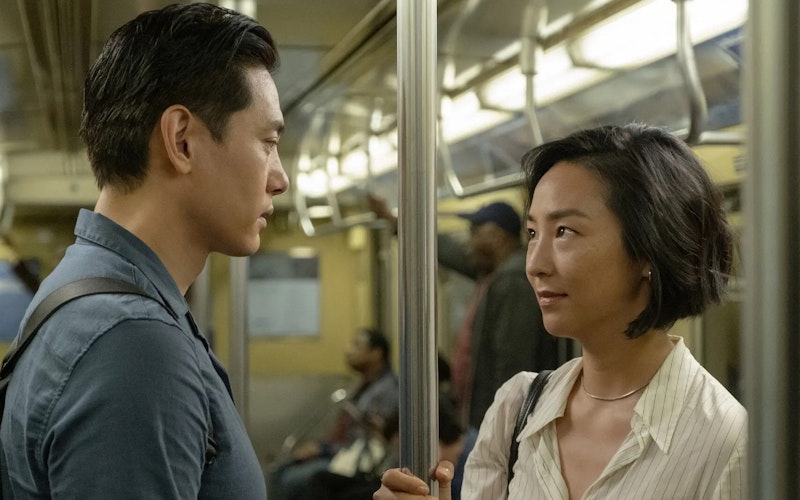
Movies
Presence and Absence in Past Lives
After meeting some of our fellow coworkers in person after months of Zoom meetings, my friend Adrienne quipped that she forgot some of them had legs. Her joke perfectly encapsulated the disarming awkwardness, as well as the joy, of seeing coworkers in all their three-dimensional glory (legs and all). Now swap “coworker” with “childhood sweetheart whom you haven’t seen in the past 12 years” and you have the premise for Celine Song’s tender directorial debut Past Lives.
The movie focuses on Nora (Greta Lee) and Hae Sung (Teo Yoo), who were inseparable as children in Korea until Nora’s family immigrated to Canada. Nora and Hae Sung reconnect innocently during the early inception of Facebook and have Skype calls on and off as they’re starting their respective careers. But life and busyness get in the way of a sustained relationship and the two fall out of contact. They don’t meet in person until 12 years later, although at that point, there are more layers of distance. She’s a writer in New York, while he’s an engineer in Seoul. He’s still hopelessly in love with her, but she’s married to a fellow writer, Arthur (John Magaro). Their first in-person meeting captures the awkwardness and joy of people reuniting for the first time after having not seen each other in years.
Indeed, one of the themes that grounds Past Lives is the idea that presence can create distance as much as it can foster connection. When Nora and Hae Sung first meet, their greetings are remarkably subdued. They awkwardly hug and exchange few words apart from repeatedly saying “와” (wa) (a Korean phrase used to indicate surprise). It’s evident that there’s a multitude of thoughts and emotions both could convey, but such depth of expression would betray the moment. Part of what contributes to their dissonance is the reality that who they were to each other in the past is not who they are at present. To see the other person is like also seeing their own past self. For Nora in particular, Hae Sung represents a part of her life that not even Arthur knows, a time when she went by her Korean name, Na Young, before assimilating in the West.
Watching this all unfold, I was reminded of what priest and theologian Henri Nouwen offered on the paradox of the distance and closeness that comes with presence: “One of the mysteries of life is that memory can often bring us closer to each other than can physical presence. . . . Indeed, many of our disappointments and frustrations in life are related to the fact that seeing and touching each other does not always create the closeness we seek.”
This is felt all throughout Nora and Hae Sung’s relationship; their memories of each other are, in many ways, stronger than how they see each other at present. Seeing each other produces more questions. Could they have been lovers if Nora never left Korea? Could they still be lovers? Visually, this interplay is captured when the two stand in a subway car while sightseeing in New York City. As they hold onto poles while the train moves, there’s a shimmering effect that creates multiple reflections of the two of them as they stare at each other. Their multiple selves are also in dialogue with each other even as they remain stationary.
One of the themes that grounds Past Lives is the idea that presence can create distance as much as it can foster connection.
The bittersweet ending of Past Lives conveys another truth: that to be alive is to change. (Slight spoilers ahead.) The distance one may feel with a friend, co-worker, or would-be lover is not always something to be mourned; that distance may represent growth and transformation, a reminder that we do not remain stagnant. For Nora and Hae Sung, they have built and developed their lives too much to be idealistic about a future where they end up together. There is a sadness there and yet also a great beauty; their mutual realization of this means that their relationship has grown and that they have grown as people. It’s a unique blend of grief and gratitude. Nouwen’s ending line of his reflection applies here too: “The more experience in living we have, the more we sense that closeness grows in the continuous interplay between presence and absence.”
Nouwen’s comments make me think of how the disciples must have felt when they encountered Jesus in his resurrected body, an even unlikelier reunion than that of Hae Sung and Nora. Whether it was Thomas, who wouldn’t believe Jesus had risen unless he put his fingers in the wounds, or those who encountered him on theEmmaus road, simply seeing Jesus did not immediately bring, as Nouwen put it, the “closeness [they] sought.” His present form stood in contrast with the last time they saw his broken, crucified body. And yet, in this dissonance there was also great hope. Jesus, carrying the scars from his crucifixion in a body both familiar and unfamiliar, was proof that “the old has gone, the new is here!” It signaled the beginning of something new—the start of a redeemed relationship between human beings and our Creator.
Likewise, in our relationships, finite beings that we are, we will go through seasons of closeness and distance. And yet, as Past Lives shows us, we need not always fear or mourn that distance. May we be encouraged by the story of Nora and Hae Sung, unafraid to press into relationships and accept them as they change, knowing that it only means we’re becoming more and more alive.
Topics: Movies